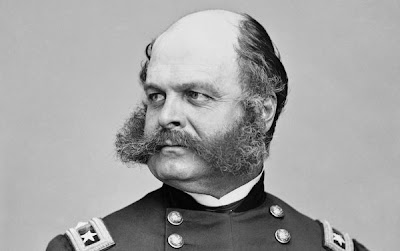On this day in 1864 the Union Army under the command of General Ambrose Burnsides, (b.1824-1881) in an attempt to break the Siege of Petersburg, Virginia (June 1864-April 1865), exploded an over 500 foot mine dug under Confederate defense in the weeks before in an attempt to overrun General Robert E. Lee's (b.1807-1870) positions.
Burnsides, the now iconic namesake of sideburns became infamous for this half-cocked, immensely dangerous and ultimately very costly assault. He became the scapegoat and was truly to blame for the disastrous & pointless attacks that followed the explosion of 320 kegs of black powder in the mine dug weeks before by engineers.
The explosion failed to open a significant breach anywhere along the Confederate lines. It succeeded in creating a large and relatively deep crater, a sort of canyon or hole which later cost thousands of Union lives during futile charges and assaults to break the line were repelled by accurate and deadly Confederate batteries and rifle fire. It was a bloody fight in the crate in which the Union army soldiers who attempted to breach the siege lines were decisively beaten back. The Siege of Petersburg would continue on until March 1865.
Burnside lost close to 4,000 men with missing, wounded, or captured soldiers bringing this total higher after the battle and its costs were known the day after. The Confederate Army lost less than 1500 men, beating back the Union army which had a significant number of African-Americans enlistees from the 29th Connecticut Volunteer Infantry regiment and other New England regiments who Burnside initially refused to deploy according to Shelby Foote's research.
The explosion itself caused less than 300 killed or wounded and though it was cataclysmic and shocking initally it did not seem to phase the Confederate defenders, under Major General William Mahone or General Lee, the latter being who the operation was directed at through the overall Union commander at Petersburg, General George Meade (b.1815-1872). Meade, who had wanted to break 'Lee's line' ensured that Burnside's military career ended after the disaster at the Crater. General Burnsides returned home to Rhode Island shortly after serving as a senator until his death in the year 1881.
At the end of the Battle of the Crater, historian and author Shelby Foote (b.1916-2005) describes the after effects of the explosion nicely, "by nightfall, all that remained as evidence of this latest bizarre attempt to break Lee's line was a raw scar-which in time would green over and loose its jagged edge, but would never really heal."
Battle of the Crater, July 30, 1864
Burnsides, the now iconic namesake of sideburns became infamous for this half-cocked, immensely dangerous and ultimately very costly assault. He became the scapegoat and was truly to blame for the disastrous & pointless attacks that followed the explosion of 320 kegs of black powder in the mine dug weeks before by engineers.
The explosion failed to open a significant breach anywhere along the Confederate lines. It succeeded in creating a large and relatively deep crater, a sort of canyon or hole which later cost thousands of Union lives during futile charges and assaults to break the line were repelled by accurate and deadly Confederate batteries and rifle fire. It was a bloody fight in the crate in which the Union army soldiers who attempted to breach the siege lines were decisively beaten back. The Siege of Petersburg would continue on until March 1865.
The Great Blunderer, General Burnsides
Burnside lost close to 4,000 men with missing, wounded, or captured soldiers bringing this total higher after the battle and its costs were known the day after. The Confederate Army lost less than 1500 men, beating back the Union army which had a significant number of African-Americans enlistees from the 29th Connecticut Volunteer Infantry regiment and other New England regiments who Burnside initially refused to deploy according to Shelby Foote's research.
Slaughter in the Crater
The explosion itself caused less than 300 killed or wounded and though it was cataclysmic and shocking initally it did not seem to phase the Confederate defenders, under Major General William Mahone or General Lee, the latter being who the operation was directed at through the overall Union commander at Petersburg, General George Meade (b.1815-1872). Meade, who had wanted to break 'Lee's line' ensured that Burnside's military career ended after the disaster at the Crater. General Burnsides returned home to Rhode Island shortly after serving as a senator until his death in the year 1881.
Major General William Mahone (b.1826-1895)
At the end of the Battle of the Crater, historian and author Shelby Foote (b.1916-2005) describes the after effects of the explosion nicely, "by nightfall, all that remained as evidence of this latest bizarre attempt to break Lee's line was a raw scar-which in time would green over and loose its jagged edge, but would never really heal."
The Crater in 1865




